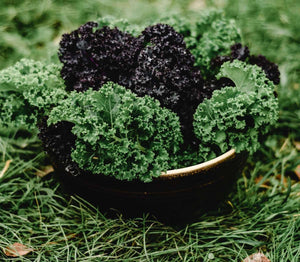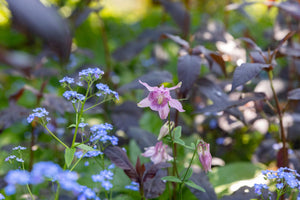Topics
How to Grow Scrumptious Alpine Strawberries from Seed
StrawberriesImagine walking through your garden on a warm summer day. You stop to smell the fragrant flowers and then pop a small red berry into your mouth. Its flavor is intense and sweet, a completely unexpected surprise for something so small.
You can hardly believe this delightful little plant is yours to eat all summer long.

Growing Alpine Strawberries in Your Garden
Alpine strawberries are the ultimate edible flower. The plants are small with lush green foliage. From June to October, they will have delicate flowers with a yellow center and white petals. The best part is the incredibly flavorful berries hiding beneath the leaves and white flowers.
These wild strawberries have an intense flavor. While the leaves and flowers look similar to hybrid strawberries, their size is much smaller. Which means their flavor is much more concentrated. They also don’t last as long, so you’ll enjoy a daily stroll through your garden to enjoy a fresh harvest each day.
Alpine strawberries are easy to add to your garden. You can grow them in pots, rock gardens, flower gardens, or around trees like you would find them in an alpine location. Just make sure you have easy access to them for eating all summer long.
How to Grow Alpine Strawberries from Seed
You can enjoy delicious alpine strawberries the first year you plant them. Starting seeds indoors will give you extra growing time so the plants are ready to flower and produce fruit in June.
Tips for fail-proof strawberry seed germination
-
Start seeds early indoors. Start alpine strawberry seeds 6 to 8 weeks before the last spring frost to ensure a harvest of sweet berries in your first year.
-
Don’t plant seeds too deep. Strawberry seeds are tiny! Tiny seeds don’t have a lot of energy to push out of the soil, so place seeds on top of the soil and mist gently to water.
-
Keep seeds moist. Use a humidity dome to keep them from drying out.
-
Strawberry seeds need light to germinate. Keep a grow light close and keep it on for 12 to 14 hours a day.
-
Keep soil warm. The optimal temperature for strawberry seed germination is 65-75ºF.
Be patient. Seeds can take 14 to 21 days to germinate.

Transplanting Strawberry Seedlings
When strawberry seedlings are several inches tall and have at least two sets of true leaves, you can start preparing them for transplanting. Harden off the seedlings by slowly acclimating them to outdoor conditions. Set them outside in a sheltered spot for one hour. Gradually increase the time by an hour each day, bringing them in at night.
When they are ready to be transferred to the garden, space strawberry plants 12 to 18 inches apart.
Bury the seedlings only to the crown of the plant. Don’t bury the crown.
If you have adequate light indoors, you can also pot up your strawberry plants before transplanting outdoors.

How to Maintain Alpine Strawberry Plants
Choosing the right location will affect the fruit production of your strawberry plants. They need full sun, fertile soil, and consistent moisture. And since they produce fruit from summer to fall, you will also want to put them in a location where it is easy to harvest the ripe strawberries.
Sun
Strawberries prefer full sun. They can grow in part shade with as little as 4 hours of direct light. But for optimal fruit production, alpine strawberries will need more than 6 hours of sunlight daily.
Soil
Well-draining soil that is nutrient-rich is the best for growing alpine strawberries. Heavy clay soil will hold too much water, resulting in root rot. Soil with a high sand content may not contain enough nutrients. A slightly acidic soil with a pH of 5.5 to 6.5 is optimal.
Water
Shallow roots mean that strawberry plants need frequent watering. Keep the soil moist but not waterlogged.
Organic mulches can help prevent water loss and keep the soil cool. Pine needles are a good choice since they are more acidic, and strawberries prefer slightly acidic soil.

Fertilizing Strawberry Plants
Strawberries are heavy feeders. They need nutrient-rich soil to produce an abundance of fruit.
In the spring, you can add compost or slow-release fertilizer. The plants produce fruit all summer, so they will also benefit from additional compost. A balanced fertilizer will help with root growth, leaves, flowers, and fruit.
Strawberry Tips
Companion planting with other flowering plants can increase strawberry production. Bees are needed to pollinate the flowers and turn them into berries. Borage is a popular companion plant for alpine strawberries. The blue borage flowers are full of nectar and are very attractive to bees. Wildflowers will also attract more bees, which will increase the pollination and production of berries.
Remove strawberry flowers for the first few weeks. In the first year, when the plant is still developing a root system, removing flowers can encourage it to put its energy into root growth instead of fruit production.
In the winter, the strawberry plants will die back. But they can tolerate cold as low as -20ºF. They are “alpine,” after all. Cover your strawberry plants with mulch for the winter to ensure they come back next spring.
Alpine strawberries are perennials but can decline in production after a few years. Dividing them every few years can help them stay healthy and productive. To divide strawberry plants, dig them up in spring and divide the clumps of roots from the center.
Keep your strawberry patch weed-free for healthy, vigorous plants. Weeds can compete with strawberry plants because of their shallow roots.

Solutions for strawberry pests and diseases
Alpine strawberries are delicious and attractive to birds and other animals. Their small size helps them hide behind the leaves, so hungry critters often miss them. But if you notice birds getting to your ripe strawberries before you do, use nets or covers to keep them away.
Slugs and snails can be a problem on strawberry plants that are too wet. Use traps and preventative methods to keep slugs and snails from eating your strawberries.
If aphids become a problem, use natural ways to eliminate them and protect your strawberry plants.

Harvesting Strawberries
Once a strawberry plant starts flowering, the berries will be ready to pick in about 30 days.
You may be tempted to pick them as soon as possible, but alpine strawberries won’t be sweet until they are fully ripe.
As soon as they are red, alpine strawberries are ready to harvest. You will want to pick them as soon as you see them change color before any critters can eat them. They also start to soften quickly, so check daily for the ripest berries.
Alpine strawberries are considered everbearing, meaning they will flower and fruit until the first fall frost.
This variety of strawberries is a delightful treat for the senses. Regina Alpine Strawberry produces small, aromatic berries with a rich, sweet flavor. This compact, perennial plant is perfect for borders or containers, boasting lush green foliage and a bounty of delightful fruit throughout the summer months.
Strawberry FAQs
Can strawberries be grown in containers?
Alpine strawberries are a beautiful plant for containers. However, you will want to ensure the soil doesn’t dry out. The pot must also drain well so the roots don’t become waterlogged.
Do alpine strawberries produce fruit all summer?
Alpine strawberries will continue to flower and fruit until the first frost. Sufficient sunlight and water will keep your plants healthy and fruiting all summer. They are considered day-neutral strawberries. Which means they will bear fruit even when days are shorter or longer. It’s the cold that eventually makes them stop bearing fruit.
Why are my strawberries deformed?
Strawberries need lots of visits from pollinators for the flowers to fully develop into a berry. If you consistently have fruit that isn’t fully formed, then you need to attract more pollinators to your garden. Try planting wildflowers or borage around your strawberry plants.
Do alpine strawberry seeds need cold stratification?
Cold stratification can improve germination rates but is not required. Place seeds in the refrigerator for 3 to 4 weeks before planting.
If you love the taste of strawberries, you need to add alpine strawberries to your garden. Not only are they incredibly flavorful, but they’re a beautiful plant that works well in a variety of garden spaces.
Start with these reliable heirloom strawberry seeds and start enjoying a delicious harvest.
Popular Posts
-

How to Grow Kale From Seed For a Nutritious Harvest All Year Round
-

What Plants Grow Well in Shade? 20+ Great Options for Success






Leave a comment